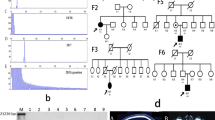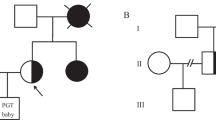Abstract
Seven different chromosomal loci, designatedSCA1 toSCA7 (spinocerebellar ataxias), have been identified as responsible for autosomal dominant cerebellar ataxias. Five genes (SCA1, 2, 3, 6, 7) have been cloned to date and show a single type of mutation, an unstable expansion of a CAG repeat coding for a polyglutamine stretch in the corresponding protein. We describe an improved polymerase chain reaction assay, based on a touchdown protocol, for the diagnosis of spinocerebellar ataxia type 2. This method produces an efficient amplification of both normal and pathological alleles and no radioactive labelling is necessary to observe the amplification products. The pathological alleles are identified by a simple non-denaturing polyacrylamide electrophoretic separation followed by ethidium bromide staining. A comparison of this technique with previously reported methods confirmed its utility for the rapid molecular diagnosis of spinocerebellar ataxia type 2. We found that the spinocerebellar ataxia type 2 mutation is responsible for 88% of the examined autosomal dominant cerebellar ataxia type 1 families in our territory (eastern Sicily). With the rapid touchdown polymerase chain reaction method, the trinucleotide expansion was also observed in 2 ataxic patients without family history of the disease, suggesting the necessity for analysis of spinocerebellar ataxia type 2 expansion even in sporadic patients.
Similar content being viewed by others
References
Harding AE. The clinical features and classification of the late onset autosomal dominant cerebellar ataxias. A study of 11 families, including descendants of the “the Drew family of Walworth”. Brain 1982; 105: 1.
Zoghbi HY. The spinocerebellar degnerations. Curr Neurol 1991; 11: 121.
Orr HT, Chung M, Banfi S, Kwiatkowski TJ Jr, Servadio A, Beaudet AL, McCall AE, Duvick LA, Ranum LPW, Zoghbi HY. Expansion of an unstable trinucleotide CAG repeat in spinocerebellar ataxia type 1. Nat Genet 1993; 4: 221.
Gispert S, Twells R, Orozco G, et al. Chromosomal assignment of the second locus for autosomal dominant cerebrellar ataxia (SCA2) to chromosome 12q 23–24.1. Nat Genet 1993; 4: 295.
Ranum LPW, Schut LJ, Lundgren JK, Orr HT, Livingston DM. Spinocerebellar ataxia type 5 in a family descended from the grandparents of President Lincoln maps to chromosome 11. Nat Genet 1994; 8: 280.
Kawaguchi Y, Okamoto T, Taniwaki M, et al. GAG expansions in a novel gene for Machado-Joseph disease at chromosome 14q 32.1. Nat Genet 1994; 8: 221.
Flanigan K, Gardner K, Alderson K, Galster B, Otterud B, Leppert MF, Kaplan C, Ptacek LJ. Autosomal dominant spinocerebellar ataxia with sensory axonal neuropathy (SCA4): clinical description and genetic localization to chromosome 16q 22.1. Am J Hum Genet 1996; 59: 392.
Zhuchenko O, Bailey J, Bonnen P, Ashizawa T, Stockton DW, Amos C, Dobyns WB, Subramony SH, Zoghbi HY, Lee C. Autosomal dominant cerebellar ataxia (SCA6) associated with small polyglutamine expansions in the alpha (1A)-voltage-dependent calcium channel. Nat Genet 1997; 15: 62.
David G, Abbas N, Stevanin G, Durr A, Yvert G, Cancel G, Weber C, Imbert G, Saudou F, Antoniou E, Drabkin H, Gemmill R, Giunti P, Benomar A, Wood N, Ruberg M, Agid Y, Mandel JL, Brice A. Cloning of theSCA7 gene reveals a highly unstable CAG repeat expansion. Nat Genet 1997; 17: 65.
Imbert G, Saudou F, Yvert G, et al. Cloning of the gene for spinocerebellar ataxia 2 reveals a locus with high sensitivity to expanded CAG/glutamine repeats. Nat Genet 1996; 14: 285.
Sanpei K, Takano H, Igarashi S, et al. Identification of the spinocerebellar ataxia type 2 gene using a direct identification of repeat expansion and cloning technique, DIRECT. Nat Genet 1996; 14: 277.
Pulst S, Nechiporuk A, Nechiporuk T, et al. Moderate expansion of a normally biallelic trinucleotide repeat in spinocerebellar type 2. Nat Genet 1996; 14: 269.
Lindblad K, Savontaus ML, Stevanin G, Holmberg M, Digre K, Zander C, Ehrsson H, David G, Benomar A, Nikoskelainen E, Trottier Y, Holmgren G, Ptacek LJ, Anttinen A, Brice A, Schalling M. An expanded CAG repeat sequence in spinocerebellar ataxia type 7. Genome Res 1996; 6: 965.
Giunti P, Sweeney MG, Spadaro M, et al. The trinucleotide repeat expansion on chromosome 6 p (SCA1) in autosomal dominant cerebellar ataxia. Brain 1994; 117: 645.
Dubourg O, Durr A, Cancel G, et al. Analysis of theSCA1 CAG repeat in large number of families with dominant ataxia: clinical and molecular correlations. Ann Neurol 1995; 37: 176.
De Michele G, Santoro L, Calabrese O, Castaldo I, Giuffrida S, Restivo D, Serlenga L, Scala R, Coppola G, Grimaldi G, Cocozza S, Filla A.SCA2 is the most frequent cause of autosomal dominant cerebellar ataxia in southern Italy. Ital J Neurol Sci [Suppl] 1997; 4: 26.
Lorenzetti D, Bohlega S, Zoghbi HY. The expansion of the CAG repeat in ataxin-2 is a frequent cause of autosomal dominant spinocerebellar ataxia. Neurology 1997; 49: 1009.
Condorelli DF, Nicoletti VG, Barresi V, Caruso A, Conticello S, De Vellis J, Giuffrida Stella AM. Tissue-specific DNA methylation patterns of the rat glial fibrillary acidic protein gene. J Neurosci Res 1994; 39: 694.
Banfi S, Servadio A, Chung MY, Kwiatkowski TJ Jr, McCall AE, Duvick LA, Shen Y, Roth EJ, Orr HT, Zoghbi HY. Identification and characterization of the gene causing type 1 spinocerebellar ataxia. Nat Genet 1994; 7: 513.
Sambrook J, Fritsch EF, Maniatis T. Molecular cloning: a laboratory manual. Cold Spring Harbor, New York: Cold Spring Harbor Laboratory Press, 1989.
Don RH, Cox PT, Wainwright BJ, Baker K, Mattick JS. “Touch-down” PCR to circumvent spurious priming during gene amplification. Nucleic Acids Res 1991; 19: 4008.
Author information
Authors and Affiliations
Rights and permissions
About this article
Cite this article
Condorelli, D.F., Trovato-Salinaro, A., Spinella, F. et al. Rapid touchdown PCR assay for the molecular diagnosis of spinocerebellar ataxia type 2. Int J Clin Lab Res 28, 174–178 (1998). https://doi.org/10.1007/s005990050039
Received:
Accepted:
Issue Date:
DOI: https://doi.org/10.1007/s005990050039




